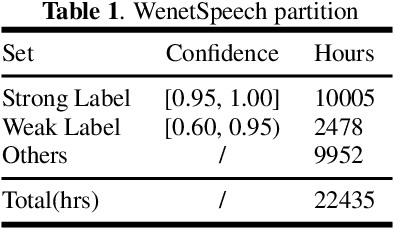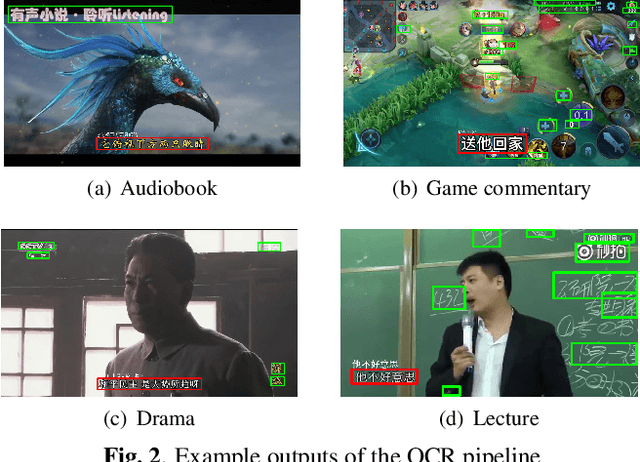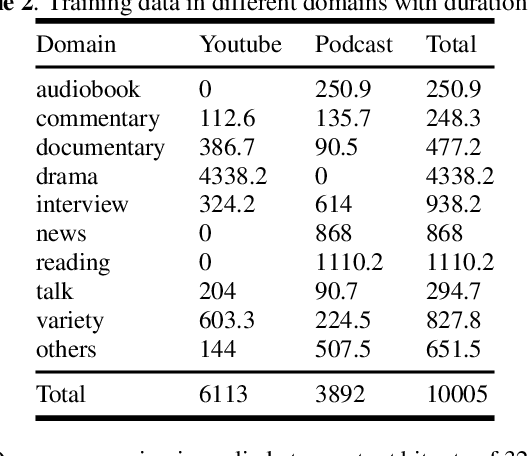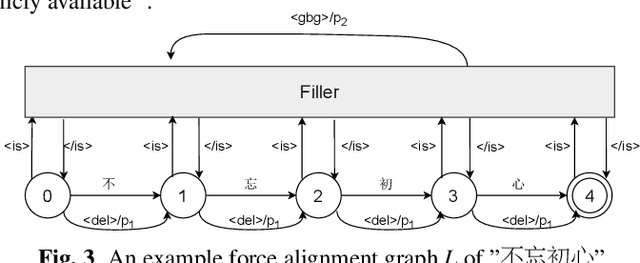Hang Lv
TELEVAL: A Dynamic Benchmark Designed for Spoken Language Models in Chinese Interactive Scenarios
Jul 24, 2025Abstract:Spoken language models (SLMs) have seen rapid progress in recent years, along with the development of numerous benchmarks for evaluating their performance. However, most existing benchmarks primarily focus on evaluating whether SLMs can perform complex tasks comparable to those tackled by large language models (LLMs), often failing to align with how users naturally interact in real-world conversational scenarios. In this paper, we propose TELEVAL, a dynamic benchmark specifically designed to evaluate SLMs' effectiveness as conversational agents in realistic Chinese interactive settings. TELEVAL defines three evaluation dimensions: Explicit Semantics, Paralinguistic and Implicit Semantics, and System Abilities. It adopts a dialogue format consistent with real-world usage and evaluates text and audio outputs separately. TELEVAL particularly focuses on the model's ability to extract implicit cues from user speech and respond appropriately without additional instructions. Our experiments demonstrate that despite recent progress, existing SLMs still have considerable room for improvement in natural conversational tasks. We hope that TELEVAL can serve as a user-centered evaluation framework that directly reflects the user experience and contributes to the development of more capable dialogue-oriented SLMs.
BoSS: Beyond-Semantic Speech
Jul 23, 2025Abstract:Human communication involves more than explicit semantics, with implicit signals and contextual cues playing a critical role in shaping meaning. However, modern speech technologies, such as Automatic Speech Recognition (ASR) and Text-to-Speech (TTS) often fail to capture these beyond-semantic dimensions. To better characterize and benchmark the progression of speech intelligence, we introduce Spoken Interaction System Capability Levels (L1-L5), a hierarchical framework illustrated the evolution of spoken dialogue systems from basic command recognition to human-like social interaction. To support these advanced capabilities, we propose Beyond-Semantic Speech (BoSS), which refers to the set of information in speech communication that encompasses but transcends explicit semantics. It conveys emotions, contexts, and modifies or extends meanings through multidimensional features such as affective cues, contextual dynamics, and implicit semantics, thereby enhancing the understanding of communicative intentions and scenarios. We present a formalized framework for BoSS, leveraging cognitive relevance theories and machine learning models to analyze temporal and contextual speech dynamics. We evaluate BoSS-related attributes across five different dimensions, reveals that current spoken language models (SLMs) are hard to fully interpret beyond-semantic signals. These findings highlight the need for advancing BoSS research to enable richer, more context-aware human-machine communication.
Interpretable Clustering Ensemble
Jun 06, 2025Abstract:Clustering ensemble has emerged as an important research topic in the field of machine learning. Although numerous methods have been proposed to improve clustering quality, most existing approaches overlook the need for interpretability in high-stakes applications. In domains such as medical diagnosis and financial risk assessment, algorithms must not only be accurate but also interpretable to ensure transparent and trustworthy decision-making. Therefore, to fill the gap of lack of interpretable algorithms in the field of clustering ensemble, we propose the first interpretable clustering ensemble algorithm in the literature. By treating base partitions as categorical variables, our method constructs a decision tree in the original feature space and use the statistical association test to guide the tree building process. Experimental results demonstrate that our algorithm achieves comparable performance to state-of-the-art (SOTA) clustering ensemble methods while maintaining an additional feature of interpretability. To the best of our knowledge, this is the first interpretable algorithm specifically designed for clustering ensemble, offering a new perspective for future research in interpretable clustering.
Adaptive Schema-aware Event Extraction with Retrieval-Augmented Generation
May 13, 2025Abstract:Event extraction (EE) is a fundamental task in natural language processing (NLP) that involves identifying and extracting event information from unstructured text. Effective EE in real-world scenarios requires two key steps: selecting appropriate schemas from hundreds of candidates and executing the extraction process. Existing research exhibits two critical gaps: (1) the rigid schema fixation in existing pipeline systems, and (2) the absence of benchmarks for evaluating joint schema matching and extraction. Although large language models (LLMs) offer potential solutions, their schema hallucination tendencies and context window limitations pose challenges for practical deployment. In response, we propose Adaptive Schema-aware Event Extraction (ASEE), a novel paradigm combining schema paraphrasing with schema retrieval-augmented generation. ASEE adeptly retrieves paraphrased schemas and accurately generates targeted structures. To facilitate rigorous evaluation, we construct the Multi-Dimensional Schema-aware Event Extraction (MD-SEE) benchmark, which systematically consolidates 12 datasets across diverse domains, complexity levels, and language settings. Extensive evaluations on MD-SEE show that our proposed ASEE demonstrates strong adaptability across various scenarios, significantly improving the accuracy of event extraction.
SQ-Whisper: Speaker-Querying based Whisper Model for Target-Speaker ASR
Dec 07, 2024Abstract:Benefiting from massive and diverse data sources, speech foundation models exhibit strong generalization and knowledge transfer capabilities to a wide range of downstream tasks. However, a limitation arises from their exclusive handling of single-speaker speech input, making them ineffective in recognizing multi-speaker overlapped speech, a common occurrence in real-world scenarios. In this study, we delve into the adaptation of speech foundation models to eliminate interfering speakers from overlapping speech and perform target-speaker automatic speech recognition (TS-ASR). Initially, we utilize the Whisper model as the foundation for adaptation and conduct a thorough comparison of its integration with existing target-speaker adaptation techniques. We then propose an innovative model termed Speaker-Querying Whisper (SQ-Whisper), which employs a set number of trainable queries to capture speaker prompts from overlapping speech based on target-speaker enrollment. These prompts serve to steer the model in extracting speaker-specific features and accurately recognizing target-speaker transcriptions. Experimental results demonstrate that our approach effectively adapts the pre-trained speech foundation model to TS-ASR. Compared with the robust TS-HuBERT model, the proposed SQ-Whisper significantly improves performance, yielding up to 15% and 10% relative reductions in word error rates (WERs) on the Libri2Mix and WSJ0-2Mix datasets, respectively. With data augmentation, we establish new state-of-the-art WERs of 14.6% on the Libri2Mix Test set and 4.4% on the WSJ0-2Mix Test set. Furthermore, we evaluate our model on the real-world AMI meeting dataset, which shows consistent improvement over other adaptation methods.
MuseGraph: Graph-oriented Instruction Tuning of Large Language Models for Generic Graph Mining
Mar 13, 2024Abstract:Graphs with abundant attributes are essential in modeling interconnected entities and improving predictions in various real-world applications. Traditional Graph Neural Networks (GNNs), which are commonly used for modeling attributed graphs, need to be re-trained every time when applied to different graph tasks and datasets. Although the emergence of Large Language Models (LLMs) has introduced a new paradigm in natural language processing, the generative potential of LLMs in graph mining remains largely under-explored. To this end, we propose a novel framework MuseGraph, which seamlessly integrates the strengths of GNNs and LLMs and facilitates a more effective and generic approach for graph mining across different tasks and datasets. Specifically, we first introduce a compact graph description via the proposed adaptive input generation to encapsulate key information from the graph under the constraints of language token limitations. Then, we propose a diverse instruction generation mechanism, which distills the reasoning capabilities from LLMs (e.g., GPT-4) to create task-specific Chain-of-Thought-based instruction packages for different graph tasks. Finally, we propose a graph-aware instruction tuning with a dynamic instruction package allocation strategy across tasks and datasets, ensuring the effectiveness and generalization of the training process. Our experimental results demonstrate significant improvements in different graph tasks, showcasing the potential of our MuseGraph in enhancing the accuracy of graph-oriented downstream tasks while keeping the generation powers of LLMs.
Conversational Speech Recognition by Learning Audio-textual Cross-modal Contextual Representation
Oct 22, 2023Abstract:Automatic Speech Recognition (ASR) in conversational settings presents unique challenges, including extracting relevant contextual information from previous conversational turns. Due to irrelevant content, error propagation, and redundancy, existing methods struggle to extract longer and more effective contexts. To address this issue, we introduce a novel Conversational ASR system, extending the Conformer encoder-decoder model with cross-modal conversational representation. Our approach leverages a cross-modal extractor that combines pre-trained speech and text models through a specialized encoder and a modal-level mask input. This enables the extraction of richer historical speech context without explicit error propagation. We also incorporate conditional latent variational modules to learn conversational level attributes such as role preference and topic coherence. By introducing both cross-modal and conversational representations into the decoder, our model retains context over longer sentences without information loss, achieving relative accuracy improvements of 8.8% and 23% on Mandarin conversation datasets HKUST and MagicData-RAMC, respectively, compared to the standard Conformer model.
Minimizing Sequential Confusion Error in Speech Command Recognition
Jul 04, 2022

Abstract:Speech command recognition (SCR) has been commonly used on resource constrained devices to achieve hands-free user experience. However, in real applications, confusion among commands with similar pronunciations often happens due to the limited capacity of small models deployed on edge devices, which drastically affects the user experience. In this paper, inspired by the advances of discriminative training in speech recognition, we propose a novel minimize sequential confusion error (MSCE) training criterion particularly for SCR, aiming to alleviate the command confusion problem. Specifically, we aim to improve the ability of discriminating the target command from other commands on the basis of MCE discriminative criteria. We define the likelihood of different commands through connectionist temporal classification (CTC). During training, we propose several strategies to use prior knowledge creating a confusing sequence set for similar-sounding command instead of creating the whole non-target command set, which can better save the training resources and effectively reduce command confusion errors. Specifically, we design and compare three different strategies for confusing set construction. By using our proposed method, we can relatively reduce the False Reject Rate~(FRR) by 33.7% at 0.01 False Alarm Rate~(FAR) and confusion errors by 18.28% on our collected speech command set.
WeNet 2.0: More Productive End-to-End Speech Recognition Toolkit
Mar 29, 2022



Abstract:Recently, we made available WeNet, a production-oriented end-to-end speech recognition toolkit, which introduces a unified two-pass (U2) framework and a built-in runtime to address the streaming and non-streaming decoding modes in a single model. To further improve ASR performance and facilitate various production requirements, in this paper, we present WeNet 2.0 with four important updates. (1) We propose U2++, a unified two-pass framework with bidirectional attention decoders, which includes the future contextual information by a right-to-left attention decoder to improve the representative ability of the shared encoder and the performance during the rescoring stage. (2) We introduce an n-gram based language model and a WFST-based decoder into WeNet 2.0, promoting the use of rich text data in production scenarios. (3) We design a unified contextual biasing framework, which leverages user-specific context (e.g., contact lists) to provide rapid adaptation ability for production and improves ASR accuracy in both with-LM and without-LM scenarios. (4) We design a unified IO to support large-scale data for effective model training. In summary, the brand-new WeNet 2.0 achieves up to 10\% relative recognition performance improvement over the original WeNet on various corpora and makes available several important production-oriented features.
WenetSpeech: A 10000+ Hours Multi-domain Mandarin Corpus for Speech Recognition
Oct 18, 2021



Abstract:In this paper, we present WenetSpeech, a multi-domain Mandarin corpus consisting of 10000+ hours high-quality labeled speech, 2400+ hours weakly labeled speech, and about 10000 hours unlabeled speech, with 22400+ hours in total. We collect the data from YouTube and Podcast, which covers a variety of speaking styles, scenarios, domains, topics, and noisy conditions. An optical character recognition (OCR) based method is introduced to generate the audio/text segmentation candidates for the YouTube data on its corresponding video captions, while a high-quality ASR transcription system is used to generate audio/text pair candidates for the Podcast data. Then we propose a novel end-to-end label error detection approach to further validate and filter the candidates. We also provide three manually labelled high-quality test sets along with WenetSpeech for evaluation -- Dev for cross-validation purpose in training, Test_Net, collected from Internet for matched test, and Test\_Meeting, recorded from real meetings for more challenging mismatched test. Baseline systems trained with WenetSpeech are provided for three popular speech recognition toolkits, namely Kaldi, ESPnet, and WeNet, and recognition results on the three test sets are also provided as benchmarks. To the best of our knowledge, WenetSpeech is the current largest open-sourced Mandarin speech corpus with transcriptions, which benefits research on production-level speech recognition.
 Add to Chrome
Add to Chrome Add to Firefox
Add to Firefox Add to Edge
Add to Edge